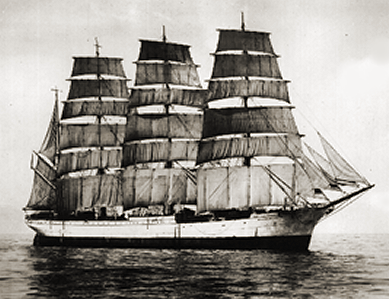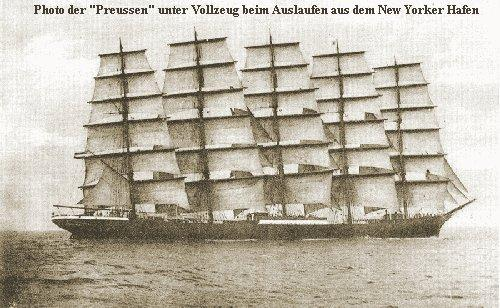|
The term "windjammer" ... indeed has swapped its original meaning: in the first place, "windjammer" was a swear word by sailors working on square riggers,
who looked down upon the smaller
Schooners
with their much easier rigging ("That aint work!"), sailing much closer to the wind = jamming the wind. In other words, it was the
Schooners
being called "windjammers", which is the opposite of the modern meaning, a nickname for the giant square riggers between 1870 and 1950.
On this small anecdote, You can feel the pride that the sailors had about their hard working life.

The German Training Ship Herzogin-Cecilie
|
Another word for windjammers is tall ships. After the
Clipper Era,
these ships were the last generation of sailing ships, competing against an ever growing fleet of steam
ships. For a short period, the race was "stand-off", as the more stable speed of steam ships had a price: much of the ship´s hold
was occupied by the machine and its coal. The sailing ships had their entire hold free for cargo, and did not have to buy an expensive machine, or coal.
Windjammers were made mostly of steel, even the masts and yards.
The most tall ships were built in the UK ("tall ships"), France ("grand voiliers"), and Germany ("Großsegler" or "Windjammer", but they pronounce it "vind yummer").
Most of the active sailing ships of today are Tall Ships or Windjammers. After World War II, all of the German sailing ships survived because they
were taken over by the Allies, foremost by the U.S. and the Soviet Union (now again Russia), and kept as training ships. And all Flying P-Liners
that were not sunk in WWII are now museums ships all over the world, with one, truely BIG exception: the "Kruzenshtern", ex Padua.
Their old role as cargo ships has vanished in the 1950s, they are almost all used as
training ships or stationary museum ships today.
A list of Tall Ships is on Wikipedia
|
These Tall Ships inherited their rigging from the
Clippers. They became even bigger and wider, using masts and yards of steel instead of wood.
-
Bowsprit: 3-5 fore triangular staysails [staysail, inner jib, jib, outer jib, flying jib], no sprit yards
-
Fore Mast: 5-8(!) square sails [course, upper + lower topsail, upper + lower topgallant sail, royal sail, skysail, moon sail]
-
2-4 main triangular staysails
-
Main Mast: 5-8(!) square sails [course, upper + lower topsail, upper + lower topgallant sail, royal sail, skysail, moon sail ...]
-
2-4 mizzen triangular staysails
-
Mizzen Mast: a quadrangular "spanker" mizzen sail, and 3-6 square sails [upper + lower topsail, upper + lower topgallant sail, royal sail, skysail]
- NOTE: sky and moon sails, the uppest yards, were not standard but
used very rarely, "flying" with a minimal running rigging, just a halyard and sheets, in light weather only.
- NOTE: in that era, stunsails came out of use, in rare cases they were much simpified: only one stunsail boom attached a the lower yard,
and triangular lower and upper stunsails only, rigged almost like staysails. One of these rare ships was the 3-mast barque "Rickmer Rickmers",
that served as "Sagres II" in the Portoguese Navy.
Sources and Books
Fortunately, many tall ships are still seaworthy or preserved in the museums. Many plans are in the archives, and as a number of them are still used
as training ships, we also can find their belaying plans.
On this theme, there are many books:
| TITLE | AUTHOR | PUBLISHER | YEAR | PAGES |
| Beatrice - Världens sista stora järnseglare | Davidsson, Jan | Forum | 1976 | 184 |
| Les derniers Cap-Horniers francais | Lacroix, Louis | Editions Maritimes et d?outre-mer | 1968 | 366 |
| Les derniers Grand Voiliers | Lacroix, Louis | Amiot-DuMont | 1950 | 512 |
| Les Grand Voiliers | Bathe, B.W. | Edita | 1975 | 260 |
| Rostocker Windjammer (Rostocks hölzerne Segler) | Rabbel, Jürgen | VEB Hinstorff | 1983 | 240 |
| Rostocks eiserne Segler | Rabbel, Jürgen | VEB Hinstorff | 1986 | 224 |
| Round Cape Hoorn Before the Mast | Lubbock, Basil | John Murray | 1902/48 | 375 |
| Rund Kap Hoorn - Die letzte Reise der "Grace Harwar" [By Way of Cape Horn]" | Viloliers, Alan | F.A.Brockhaus | 1966 | 157 |
| The Tall Ships - A Sailing Celebration | | Hamlyn | 1977 | 126 |
| The Tall Ships - A Salute to Liberty | | The Vendome Press | 1986 | 128 |
| The Tall Ships Pass (1937) | Derby, WLA | David & Charles | 1937/70 | 426 |
| The Windjammers | Allen, Oliver E. | Timelife Books, Amsterdam | 1978 | 176 |
| Windjammer | Brennecke, Jochen | Koehler | 1968 | 408 |
| Windjammer | Desmond, Shaw | Hutchinson | 1932 | 414 |
| Windjammer - Die schönsten Grossegler der Welt | Böhm, H.H. + Wiese, E. | Karl Müller | 2004 | 240 |
| Windjammer - Die schönsten Segelschiffe | Czasnojc | tosa | 2005 | 143 |
| Windjammer - Staatsraad Lehmkuhl, Sørlandet, Christian Radich | Göthesen, Göthe | Grøndahl Dreyer | 1993 | 96 |
| Windjammer Lübeck Kiel 1972 | | Koehler | 1972 | 56 |
| Windjammer Modelling | Monk, Clive | Faber | 1954 | 128 |
| Windjammer von Hamburg - Schnellsegler um 1850 | | Museum für Hamburgische Geschichte | 1977 | 20 |
| Windjammerparade | | Stalling | 1972 | 112 |
| Windjammerparade (Einmalige Sonderausgabe) | | Stalling | 1978 | 128 |
| Windjammers | Gordon, W + Lander, H | Collins | 1938 | 72 |
| Windjammers of the Horn | Course, A.G. | Adlard Coles Ltd. | 1969 | 176 |
| Windjammers Significant | Colton, J.Ferrell | J.F. Colton & Co. | 1954 | 296 |
| Wir segeln dem Teufel die Hörner ab | Gording, Peter | Ditzen & Co. | 1969 | 176 |
Belaying Schemes
Since these ships are still used as training ships, there ARE belaying scheme plans! But they are hard to find.
I am lucky to have a copy of a belaying plan of the 4-mast-barque Pamir, a Flying P-Liner.
I got it on my visit of her surviving sister ship,
the Passat, in Lübeck, Northern Germany, today a stationary museum ship.
And I only got this plan because I happened to meet an old sailorman (who had been sailing with her in the 1950s) giving a guidance tour to another visitor group (I was coming alone).
When he finished the guidance tour, I could talk to him, and he gave me the plan - the till girl selling tickets did not even know what such a plan was (of course she didn´t),
nor that those were in stock for sell ... so I would not have had any chance without meeting that friendly old seaman!
And this is my more modern version of the Pamir plan, in English and German; it is not geometric but schematic for clarity:

There are some slight differences between Pamir and Passat, although they are sister ships. The Pamir sank in 1957 in a hurricane,
and the Passat was decomissioned the same year. Now she is a museum ship in Lübeck, Germany.
Using that plan, I was also able to reconstruct a plan for the 5-masted full rigger Preussen, another P-Liner, and the tallest of all cargo sailing ships ever built,
but of which no belaying plan had prevailed - she stranded and was abandoned in 1910 before Dover.

NOTE: this is the second version I made, I found some errors in my first one I uploaded here before ...

The patterns of these belayings can still be seen alive onboard the "Kruzenshtern" and other sailing windjammers.
|



